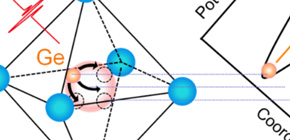
Mechanism behind ultrafast phase change of alloys for storage materials elucidated
Will contribute to the development of ultrafast and energy-saving data storage media
A phase-change chalcogenide material Ge-Sb-Te (GST) used for rewritable optical discs such as DVDs and Blu-ray discs changes between crystalline and amorphous structural phases by the irradiation of a nanosecond (ns)-laser pulse, causing great reflectivity changes. Optical discs record and read data by using this mechanism. GST has resistance to thermal changes in either the crystalline or amorphous phase, so it is used as a practical material.
In recent years, it has been reported that the phase change from the crystalline phase to the amorphous phase was induced in the GST family for a picosecond (ps:10 -12 s) through irradiation of a femtosecond (fs:10 -15 s) laser pulse, which draws attention due to the expected possibility of drastic improvement of recording speed and energy saving. Since the clarification of this ultrafast amorphous state mechanism by femtosecond laser irradiation is very important in designing materials in the future, with a few models having been proposed based on theoretical computation. However, these were not obtained by direct observation of structural changes, and the process of these structural changes was not known.
A group of researchers led by Professor MATSUBARA Eiichiro, Associate Professor ICHITSUBO Tetsu, and Project-Specific Professor YAMADA Noboru at the Graduate School of Materials Science, Kyoto University, Specially Appointed Professor TANIMURA Katsumi at the Research Center for Ultra-High Voltage Electron Microscopy, Osaka University, and Professor M. W. Chen at the World Premier International Research Center Initiative Advanced Institute for Materials Research (WPI-AIMR), measured structural changes that vary from picosecond to picosecond.
Specifically, in order to clarify the dynamics of structural change of GST alloys, in which the phase change is induced by femtosecond-optical-laser irradiation, this group conducted time-resolved X-ray diffraction (XRD) using a pump-probe method, in which an X-ray was used as a probe, at RIKEN’s X-ray Free Electron Laser at SPring-8 Angstrom Compact Free Electron Laser (SACLA).
This group clarified the chronological change of crystalline structure following femtosecond-laser excitation in Ge 2 SbTe 5 (sodium chloride structure) and GeTe (distorted sodium chloride structure), both of which are typical compositions of GST alloys, and discussed a mechanism behind ultrafast phase change of phase-change materials by comprehensively understanding results of pump-probe measurements of optical properties as well as first-principles molecular dynamics simulation.
As a result of observation and discussion, interesting movements of germanium (Ge) atoms were observed. In sodium chloride structure, Ge atoms move so as to circumvent the central position of the octahedron consisting of Te atoms. It was found that following the femtosecond-laser excitation, the movement of Ge atoms became far larger compared to the movement of Te atoms and generated a rattling motion; i.e., Ge atoms vibrate or move around the center position with keeping off-center of the octahedron. This movement is similar to swinging around a basket (Te) with a bell or ball (Ge) inside.
It is thought that this rattling motion can instantly break a unique binding mode (resonant bonding) that produces crystalline optical properties of GST, which can explain ultrafast changes in reflection ratio which have already been reported. From the study of the amorphous structures obtained from first-principles molecular dynamics simulation, it is thought that switching from resonant bonding to dimerization of Ge-Te binding was triggered, producing the amorphous state in time. This group’s achievement is significant in that they advocated a new mechanism of ultrafast phase change in the process from femtosecond excitation, to a rattling motion, dimerization, and amorphous state.
Abstract
Despite the fact that phase-change materials are widely used for data storage, no consensus exists on the unique mechanism of their ultrafast phase change and its accompanied large and rapid optical change. By using the pump-probe observation method combining a femtosecond optical laser and an x-ray free-electron laser, we substantiate experimentally that, in both GeTe and Ge 2 Sb 2 Te 5 crystals, rattling motion of mainly Ge atoms takes place with keeping the off-center position just after femtosecond-optical-laser irradiation, which eventually leads to a higher symmetry or disordered state. This very initial rattling motion in the undistorted lattice can be related to instantaneous optical change due to the loss of resonant bonding that characterizes GeTe-based phase change materials. Based on the amorphous structure derived by first-principles molecular dynamics simulation, we infer a plausible ultrafast amorphization mechanism via nonmelting.
Figure 1
Figure 2
To learn more about this research, please view the full research report entitled “ Initial atomic motion immediately following femtosecond-laser excitation in phase-change materials ” at this page of the Physical Review Letters website.
Related link

